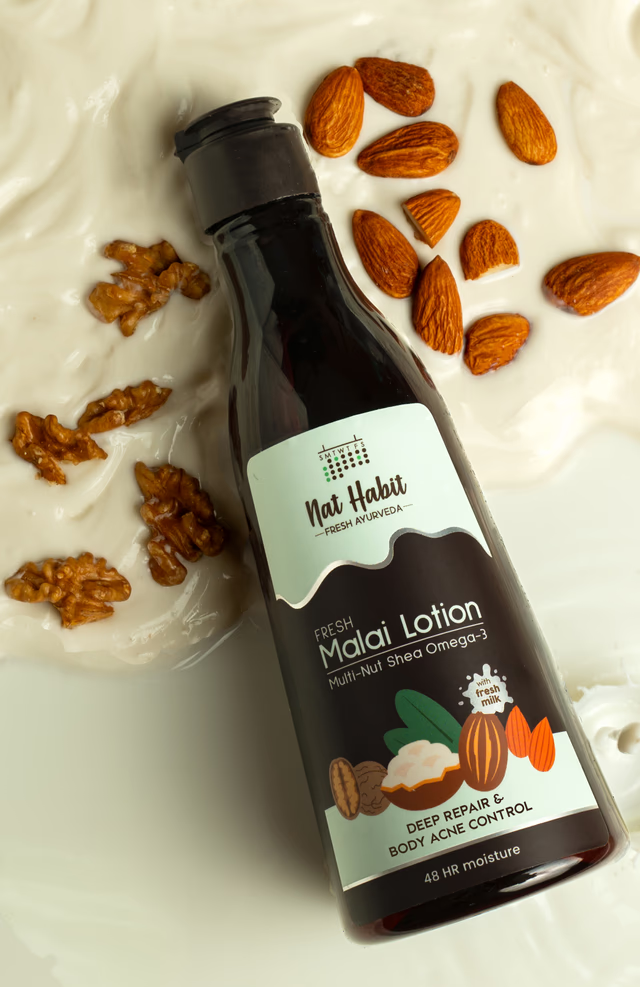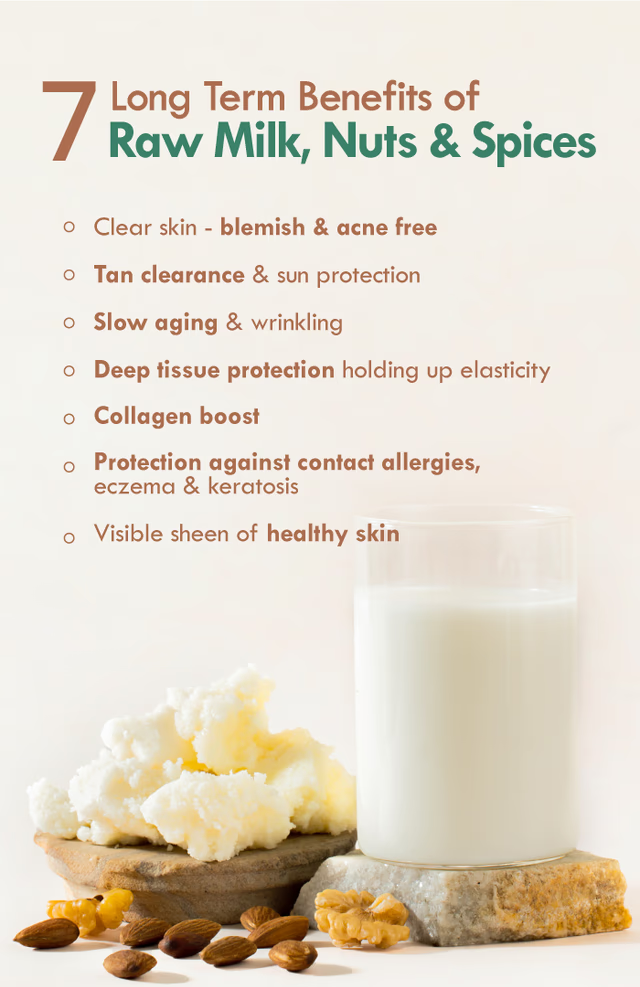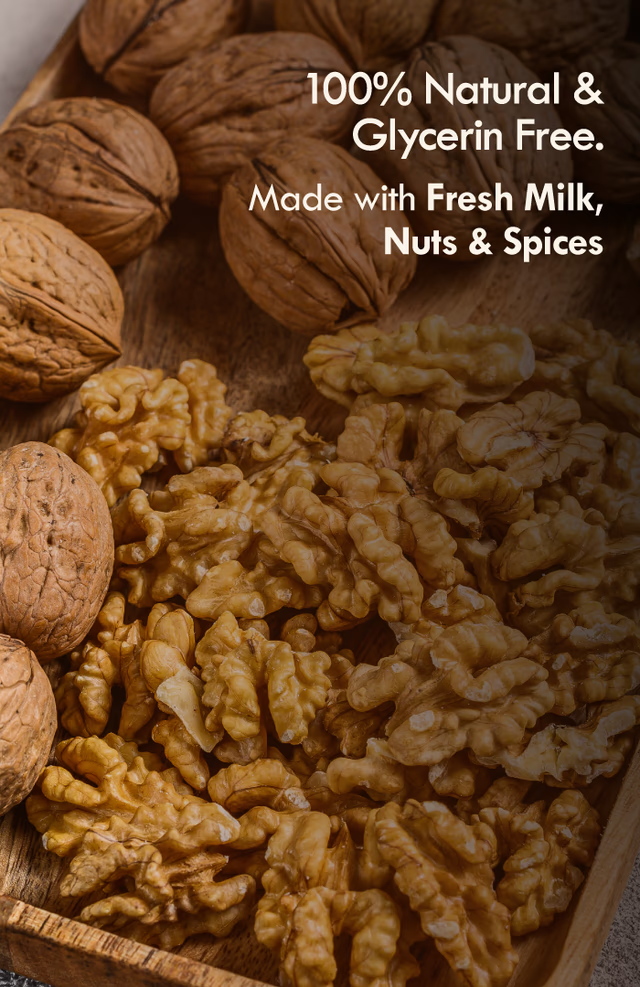Multi-Nut Shea Omega-3 Fresh Malai Lotion
Original price was: ₹615.0.₹439.0Current price is: ₹439.0.
Usage & Suitability
Note
- Description
- Additional information
- Reviews (0)
- Q & A
- Sustainability Remark
- More Offers
- Store Policies
- Inquiries
Key Benefits
Regular usage helps with
✓ 48HR moisturisation
✓ Clears body acne & keratosis pilaris
✓ Spot, blemish & tan repair
✓ Relieves flakiness & dry patches
✓ Intense night repair
Active Ingredients
Fresh & whole picks
Raw Milk
Lactic acid deep cleanses, removing acne-causing bacteria, vitamin A actively heals tissues. Clear & soften skin at one go.
Walnut
Vitamin B5 fades dark spots, clarifies skin, vitamin E actively repairs skin.
Almond
Omega acids deeply nourishes & moisturises, anti-oxidants prevents premature ageing.
Clove
Exfoliants & de-pigmenting compounds reduce acne scars, hyperpigmentation & uneven skin tone.
Full Ingredient List: raw milk, shea, walnut, almond, sesame oil, sunflower seeds, coconut fat, clove, rosemary, beeswax, geogard/nipaguard (ecocert), vanilla, rose, xanthan gum, salt, aqua.
Long Term Benefits
of raw milk, nuts & spices
Glycerin Free Moisturisation
✓ Clear skin – blemish & spot free
✓ Tan clearance & sun protection.
✓ Slow aging & wrinkling.
✓ Deep tissue protection holding up elasticity.
✓ Collagen boost.
✓ Protection against contact allergies & eczema.
✓ Visible sheen of healthy skin.
| Weight | 0.25 kg |
|---|
You must be logged in to post a review.
Q & A
1. Natural Ingredients: The use of natural and organic ingredients such as shea butter, various nut oils, and omega-rich extracts significantly reduces the environmental impact. These ingredients are typically grown with fewer synthetic fertilizers and pesticides, leading to lower environmental contamination and healthier ecosystems. 2. Sustainable Sourcing: If the ingredients are sourced from sustainable and ethical suppliers, it ensures that the farming practices protect biodiversity, prevent deforestation, and promote fair labor practices. Sustainable sourcing also involves practices that minimize soil degradation and promote the regeneration of plant resources. 3. Biodegradability: Natural ingredients tend to be more biodegradable than synthetic ones, meaning they break down more easily in the environment, reducing the risk of pollution and harm to wildlife. 4. Minimal Chemical Processing: The production process that involves minimal chemical processing reduces the release of harmful substances into the environment. This includes less energy consumption and fewer emissions associated with manufacturing.
Low Carbon Footprint of Multi-Nut Shea Omega Body Lotion
1. Low-Energy Manufacturing: Producing natural body lotions often requires less energy compared to synthetic alternatives. Processes such as cold-pressing nut oils or shea butter extraction are less energy-intensive than the synthesis of synthetic compounds. 2. Reduced Transportation Emissions: If the product ingredients are sourced locally or regionally, transportation emissions are minimized. This is particularly important for bulky ingredients like shea butter, which can have a significant carbon footprint if transported over long distances. 3. Packaging: Eco-friendly packaging, such as recycled or biodegradable materials, reduces the carbon footprint. The production and disposal of traditional plastic packaging contribute significantly to carbon emissions. 4. Supply Chain Efficiency: Efficient supply chain management that prioritizes reducing waste, optimizing logistics, and employing renewable energy sources can greatly reduce the overall carbon footprint of the product.Scientific Explanation and References
1. Natural and Organic Ingredients: Studies show that natural ingredients have lower environmental impacts due to less reliance on synthetic chemicals and fertilizers. For example, shea butter has been highlighted for its sustainable production practices and minimal processing requirements (Olaniyan & Oje, 2007). 2. Sustainable Sourcing: The importance of sustainable sourcing in reducing carbon footprint and promoting environmental health is well-documented. For instance, sourcing shea butter from women's cooperatives in West Africa has shown to support sustainable land use and socio-economic benefits (Masters, 2020). 3. Biodegradability and Minimal Chemical Processing: Biodegradability reduces long-term environmental pollution. Research by Moretto and Dutra (2007) emphasizes the importance of using biodegradable ingredients in personal care products to minimize ecological impact. 4. Low-Energy Manufacturing and Transportation: According to the World Resources Institute, transportation is a major contributor to carbon emissions. Locally sourced ingredients significantly cut down on emissions related to transportation (WRI, 2021).References
- Olaniyan, A. M., & Oje, K. (2007). Quality characteristics of shea butter recovered from shea kernel through dry extraction process. Journal of Food Science and Technology, 44(6), 655-661.
- Masters, E. T. (2020). Shea (Vitellaria paradoxa) and the global shea butter industry. International Tree Crops Journal, 10(2), 104-112.
- Moretto, E., & Dutra, R. (2007). Biodegradability of surfactants: an overview. Detergents and Cosmetics, 30, 25-36.
- World Resources Institute (WRI). (2021). Reducing the Carbon Footprint of Consumer Goods. Retrieved from WRI
General Inquiries
There are no inquiries yet.



















Reviews
There are no reviews yet.